11.2: Buddhist Art
- Page ID
- 53019
Buddhist Stupas
A stupa is a traditional Buddhist monument that houses holy relics associated with the Buddha.
Learning Objectives
Describe the common features, as well as stylistic variations, found in Buddhist stupas
Key Takeaways
Key Points
- Stupas evolved over time from simple funerary monuments to elaborately decorated objects of veneration.
- Emperor Ashoka, who ruled from 274–236 BCE during the Maurya Dynasty , is said to have redistributed the relics housed in the original stupas of the Buddha into thousands of stupas throughout India.
- All stupas contain a treasury , a Tree of Life, and small offerings known as Tsa-Tsas. It is believed that the more objects placed into the treasury, the stronger the stupa’s energy.
- There are five types of stupas: Relic stupas, Object stupas, Commemorative stupas, Symbolic stupas and Votive stupas. A stupa is thought to bring enlightenment to the one who builds and owns it; it is also considered a placed of worship for many Buddhists.
Key Terms
- relic: A part of the body of a saint, or an ancient religious object, kept for veneration.
- mantra: A phrase repeated to assist concentration during meditation.
History of Stupas
A stupa, literally meaning heap, is a mound-like structure designed to encase Buddhist relics and other holy objects. Stupas exist all over the world and are the oldest Buddhist religious monuments.
Originally a simple mound of clay or mud, stupas evolved from simple funerary monuments to become elaborately decorated objects of veneration. Legend has it that following the cremation of Buddha, his ashes were divided into eight parts and distributed among various rulers to be enshrined at special burial mounds.
Emperor Ashoka, who ruled from 274–236 BCE during the Maurya Empire, is said to have redistributed the relics housed in the original stupas into thousands of stupas throughout India. Ashoka is also credited with the construction of numerous stupas that remain to this day, including those at Sanchi and Sarnath.
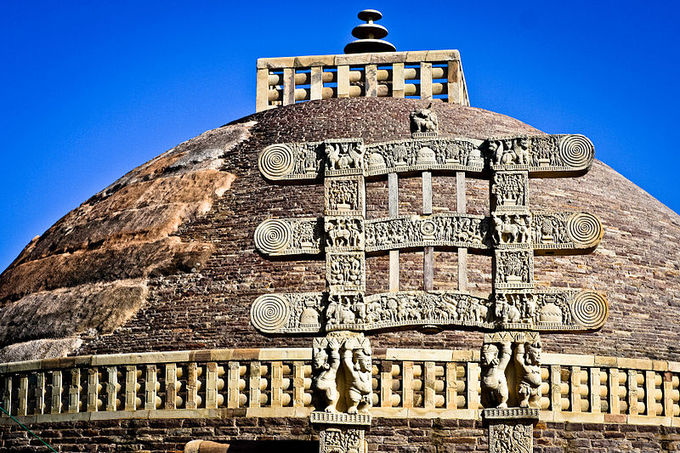
Stupa at Sanchi, India: Emperor Ashoka is credited with construction of numerous stupas that remain to this day, including the stupa at Sanchi.
Structure and Style
While they can vary visually, all stupas have a few features in common. Every stupa contains a treasury filled with various objects—small offerings, or Tsa-Tsas, fill the majority of the treasury, while jewelry and other precious objects are also placed within. It is believed that the more objects placed into the treasury, the stronger the stupa’s energy.
The Tree of Life, a wooden pole covered with gems and mantras , is an important element of every stupa and is placed in the stupa’s central channel during an initiation ceremony , where participants’ most powerful wishes are stored.
There are five types of stupas:
- Relic stupas, in which the relics of Buddha and other religious persons are buried.
- Object stupas, in which the objects belonging to Buddha or his disciples are buried.
- Commemorative stupas, built to commemorate events in the life of Buddha and his disciples.
- Symbolic stupas, built to symbolize various aspects of Buddhist theology.
- Votive stupas, constructed to commemorate visits or gain spiritual benefits.
In the Buddhist religion, it is believed that a stupa brings enlightenment to the one who builds and owns it. In addition, the stupa is considered a place of worship, and many Buddhists complete pilgrimages to significant stupas.
Buddhist Architecture and Sculpture
Sri Lankan art and architecture were deeply influenced by Buddhism, which was introduced to the island in the third century BCE.
Learning Objectives
Discuss the evolution of Buddhist art in Sri Lanka, from early cave temples to the art and architecture of the kingdom of Anuradhapura
Key Takeaways
Key Points
- Three types of structures are typically associated with the religious architecture of early Buddhism : monasteries (viharas), places to venerate relics ( stupas ), and shrines or prayer halls (chaityas or chaitya grihas). The earliest examples of Buddhist architecture found in Sri Lanka are cave temples. The most famous of these, the Dambulla temple complex, dates to the 1st century BCE.
- The kingdom of Anuradhapura (377 BCE–1017 CE), named for its capital city, produced some the finest ancient Sri Lankan art and architecture.
- Sri Lankan stupas were among the largest brick structures known to the premodern world. Intended to enshrine relics of the Buddha, they were built in various shapes and often accompanied by a vahalkada, or decorative frontispiece.
- Another architectural creation associated with stupas and unique to ancient Sri Lankan architecture was the vatadage , a circular Buddhist structure built around small stupas.
- The rock fortress and palace complex of Sigiriya is particularly renowned for its ancient frescoes of female figures bearing flowers; it dates from the fifth century and is painted in a very distinctive style .
- Sculpture was also a notable art form , and many fine statues of the Buddha were produced during the Anuradhapura period. The fourth-century Samadhi statue in Anuradhapura is considered one of the finest examples of ancient Sri Lankan sculpture.
Key Terms
- vatadage: A decorative circular frontispiece near the entrance of a Sri Lankan stupa.
- stupa: A dome-shaped Buddhist monument, used to house Buddhist relics.
Overview: Buddhist Architecture
Buddhist religious architecture developed in the Indian Subcontinent in the third century BCE. Three types of structures are typically associated with the religious architecture of early Buddhism:
- Monasteries (viharas).
- Places to venerate relics (stupas).
- Shrines or prayer halls (chaityas or chaitya grihas), which later came to be called temples in some places.
Viharas were initially only temporary shelters used by wandering monks during the rainy season, but they later developed to accommodate the growing trend towards Buddhist monasticism. A distinctive type of fortress architecture found in the former and present Buddhist kingdoms of the Himalayas is known as dzongs.
The initial function of the stupa was the veneration and safe-guarding of the relics of the Buddha. The earliest surviving example of a stupa is in Sanchi (Madhya Pradesh).
In accordance with changes in religious practice, stupas were gradually incorporated into chaitya-grihas. These reached their high point in the 1st century BCE, exemplified by the cave complexes of Ajanta and Ellora (Maharashtra). The Mahabodhi Temple at Bodh Gaya in Bihar is another well-known example.
Buddhist Architecture in Sri Lanka
Sri Lankan art and architecture was deeply influenced by Buddhism, which was introduced to the island in the third century BCE by the son of Ashoka, Mahinda. Ashoka, the great Buddhist emperor of the Maurya Dynasty , dedicated himself to the propagation of the religion across Asia. Sri Lanka has the longest continuous history of Buddhism of any Buddhist nation, and its culture reflects its religious tradition.
Cave Temples
The earliest examples of Buddhist architecture found in Sri Lanka are cave temples. The most famous of these, the Dambulla temple complex, dates back to the first century BCE. This complex consists of five caves and is decorated inside with statues and frescoes of the Buddha and various gods and goddesses from the Buddhist pantheon .
Sri Lankan Stupas
The kingdom of Anuradhapura (377 BCE to 1017 CE), named for its capital city, produced some of the finest ancient Sri Lankan art and architecture. Some of the most distinctive and famous Sri Lankan monuments were built during this period, including a large number of dagobas or stupas, for which the island is renowned.
Sri Lankan stupas were among the largest brick structures known to the premodern world. Intended to enshrine relics of the Buddha, they were built in various shapes, including the bubble, the pot, and the bell. The Sri Lankan stupa is characterized by its vahalkada, or frontispiece. It is a structure, often ornately carved, that joins the stupa and often uses cardinal directions as a decorative flourish.
One of the most famous stupas in Sri Lanka is the Jetavanaramaya stupa, which was built during the 3rd and 4th centuries CE in the sacred city of Anuradhapura; it is believed to house a part of a sash of the Buddha. Built from baked bricks bound with limestone , sand, and clay and coated with lime plaster, this stupa stands at 400 feet and was the tallest stupa in the ancient world.
The Vatadage
Another architectural creation associated with stupas and unique to ancient Sri Lankan architecture was the Vatadage, a circular Buddhist structure built around small stupas. These were usually made of stone and brick and elaborately carved. They may have also had wooden roofs that were supported by stone columns arranged in concentric rows.
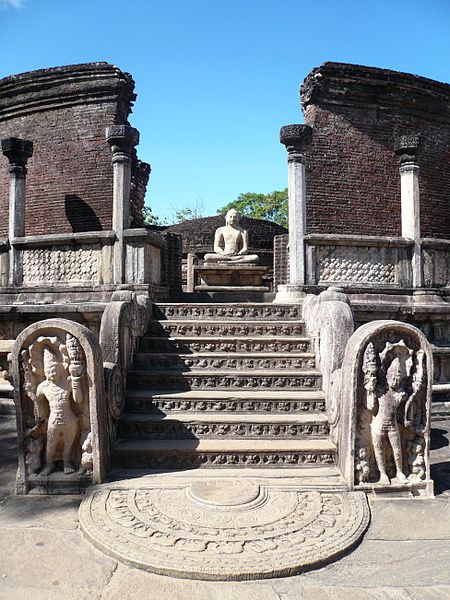
Polonnaruwa Vatadage: A vatadage in the ancient city of Polonnaruwa, Sri Lanka, from the 12th century CE.
Sigiriya
Another famous monument erected under the patronage of Anuradhapura was the rock fortress and palace complex of Sigiriya. Sigirya is particularly renowned for its ancient frescoes, which date from the 5th century and were painted in a very distinctive style.
The lines are painted in a manner that enhances the sense of volume of the figures, and the paint is applied in sweeping strokes, using more pressure on one side than the other and giving the effect of a deeper tone toward the edges. The frescoes all depict beautiful female figures who are carrying flowers and are hypothesized to be apsaras (celestial nymphs), ladies of the king’s court, or women taking part in religious rituals .
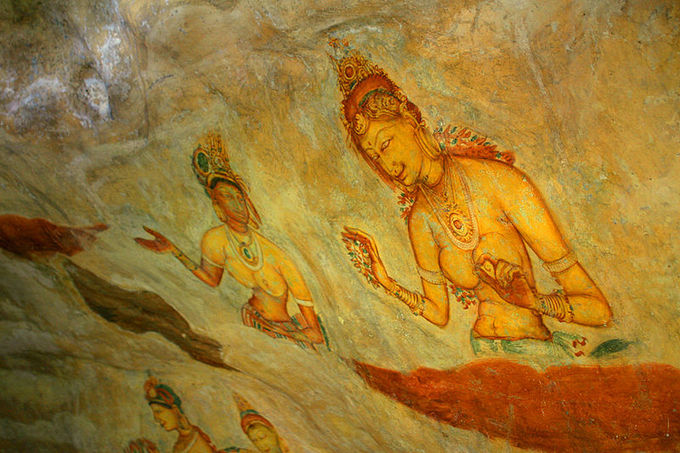
Sigiriya fresco: Depicting women with flowers, the Sigiriya frescoes are examples of a distinctive Sri Lankan school of painting from the 5th century CE.
Buddhist Sculpture
Sculpture was also a notable art form, and many fine statues of the Buddha were produced during the Anuradhapura period in Sri Lanka. The Samadhi statue in Anuradhapura is considered one of the finest examples of ancient Sri Lankan sculpture. Sculpted from dolomite marble, it dates to the 4th century CE and shows the Buddha seated in a position of deep meditation.
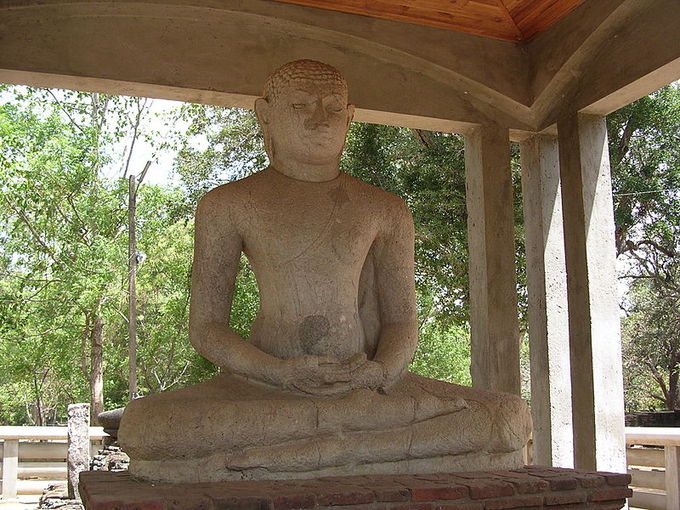
Samadhi Statue: Located in Anuradhapura, this statue dates to the fourth century CE and is a fine example of ancient Sri Lankan Buddhist sculpture.
Buddhist Rock-Cut Architecture
Rock-cut architecture is the practice of creating a structure by carving it out of solid natural rock.
Learning Objectives
Distinguish the features of the Ajanta, Barabar, and Ellora caves of India
Key Takeaways
Key Points
- Buddhist rock-cut temples and structures were often located near trade routes and became stopovers and lodging houses for traders. Their interiors became more and more elaborate as their endowments grew.
- A notable trait of rock-cut architecture is the crafting of rock to imitate timbered and carved wood.
- Cave temples have been well-preserved due to their hidden locations and the fact that they are constructed from stone, a far more durable material than wood, clay, or metal.
- The Barabar caves in Bihar, built in the third century BCE and credited to Emperor Ashoka, are the oldest example of Buddhist rock-cut architecture.
- The Ajanta caves contain some very well-preserved tempera wall paintings that illustrate the Jataka and date from the second century BCE.
- The Ellora caves are made up of twelve Buddhist, seventeen Hindu, and five Jain rock-cut temples, excavated out of the Charanandri hills. Similar to the Barabar and Ajanta caves, they contain many frescoes , reliefs , and shrines.
Key Terms
- cornice: The topmost architectural element of a building that projects forward from the main walls and was originally used to direct rainwater away from the building’s walls.
- tempera: A medium used to bind pigments in painting, as well as the associated artistic techniques.
- pilaster: A rectangular column that projects partially from the wall to which it is attached, giving the appearance of a support but used only for decoration.
Overview: Rock-Cut Architecture
Rock-cut architecture is the practice of creating a structure by carving it out of solid natural rock. In India, the term cave is often applied in reference to rock-cut architecture; however, it must be distinguished from a naturally occurring cave, as rock-cut architecture is a highly engineered and elaborately decorated structure.
There are more than 1,500 rock-cut temples in India, most of which are religious in nature, adorned with decorative paintings and exquisite stone carvings that reflect a very high level of craftsmanship.
Buddhist rock-cut temples and monasteries were often located near trade routes and these spaces became stopovers and lodging houses for traders. As their endowments grew, the interiors of rock-cut temples became more and more elaborate and decorated.
While many temples, monasteries, and stupas have been destroyed, cave temples are better preserved due to their hidden locations and the fact that they are constructed from stone, a far more durable material than wood, clay, or metal.
India’s Rock-Cut Architecture
The Barabar Caves
In India, caves have long been regarded as sacred spaces and were enlarged or entirely man-made for use as temples and monasteries by Buddhist monks and ascetics. The Barabar caves in Bihar, built in the third century BCE during the Mauryan period, are the oldest examples of Buddhist rock-cut architecture.
Credited to Emperor Ashoka, these caves mostly consist of two rooms carved entirely out of granite. The first room, a large rectangular hall, was meant to be a space for worshipers to congregate, while the second room was a small, domed chamber for worship. This second chamber is thought to have contained small, stupa-like structures, though it is empty now.
The Ajanta Caves
The Ajanta caves in Maharashtra are a group of 30 rock-cut Buddhist temples that span six centuries, beginning in the first century BCE. They are carved into the vertical side of a gorge located in the hills of the Sahyadri mountains.
The Ajanta caves are considered masterpieces of Buddhist architecture and contain living and sleeping quarters, kitchens, monastic spaces, shrines, and stupas. Made of brick or excavated from stone, the residences of monks are called viharas, while the cave shrines used for worship are called chaitya grihas.
Similar to the Barabar caves, the Ajanta caves are situated close to main trade routes. A great deal of decorative sculpture—intricately carved columns and reliefs, including cornices and pilaster—are found here.
A notable trait of rock-cut architecture is the crafting of rock to imitate timbered and carved wood. The Ajanta caves are home to some very early and well-preserved wall paintings that decorate the walls and ceilings and date from the second century BCE.
Executed using tempera technique on smooth surfaces and prepared by the application of plaster, the themes of the paintings are Buddhist and gracefully illustrate the major events of Buddha’s life, the Jataka tales , and the various divinities of the Buddhist pantheon .
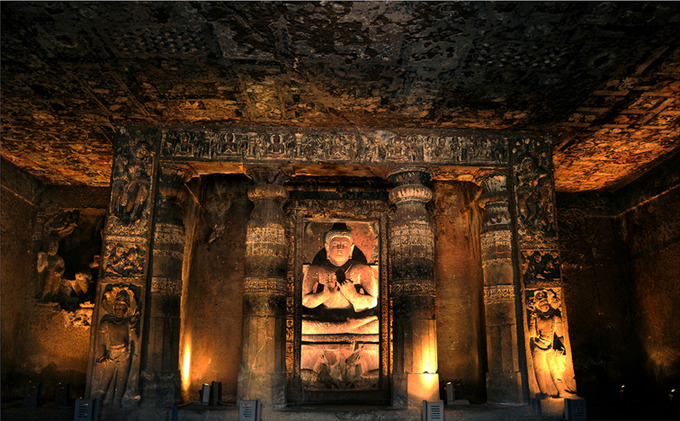
Ajanta Cave: A great deal of decorative sculptures—intricately carved columns and reliefs, including cornices and pilaster—are found in the Ajanta caves.
The Ellora Caves
The Ellora caves were built between the fifth and tenth centuries. These caves are made up of twelve Buddhist, seventeen Hindu, and five Jain rock-cut temples, excavated out of the Charanandri hills.
The proximity of the temples that belong to different religions demonstrates the religious harmony of the time. Similar to the Barabar and Ajanta caves, the Ellora caves contain many frescoes, reliefs, and shrines, including carvings of the Buddha, bodhisattvas , and saints. In many cases the stone is intricately carved to look like wood.

Ellora Cave: Similar to the Barabar and Ajanta caves, the Ellora caves contain many frescoes, reliefs, and shrines, including carvings of the Buddha, bodhisattvas, and saints.
Buddhist Wall Paintings
Buddhist wall paintings can be traced back to the Gupta period and are one of the dominant art forms of the early medieval period in India.
Learning Objectives
Describe the cave murals, rock-cut monasteries, and miniature paintings created during India’s early Medieval period
Key Takeaways
Key Points
- The period of Gupta rule is known as the Golden Age of India, as it was a time marked by peace, prosperity, and the flourishing of the arts, as seen in the cave paintings at Ajanta.
- Medieval India was a time marked by the appearance of a multitude of states and dynasties that were often in conflict with one another. The Islamic invasions began as early as the 8th century, and by the early 12th century, almost all of northern India was conquered.
- The dynasties of Medieval India were predominantly Hindu, though some were Jaina and only a very few were Buddhist.
- Murals continued to flourish during the early medieval period, mainly in caves or rock-cut temples and monasteries, such as the caves of Ellora, Bagh, and Sittanavasal.
- Miniature painting began in the early medieval period as illustrations on palm-leaf manuscripts, painted on the leaves (about 2.25 by 3 inches) and wooden covers of Hindu, Jaina, and Buddhist texts.
Key Terms
- fresco: In painting, the technique of applying water-based pigment to wet or fresh lime mortar or plaster.
- album leaves: Types of paintings that were popular among the gentry and scholar-officials of the Southern Song Dynasty.
The Gupta Empire
The Gupta Empire was an ancient Indian empire that covered much of the Indian subcontinent and was run by the Gupta Dynasty from approximately 320 to 550 CE. After the fall of the Mauryan Empire in the 2nd century BCE, India remained divided in a number of disparate kingdoms.
During the late 3rd century CE, the Gupta family gained control of the kingship of Magadha (modern-day eastern India and Bengal). The period of Gupta rule is known as the Golden Age of India, as it was a time marked by unprecedented prosperity and the flourishing of the arts and sciences in India.
Art in the Gupta Empire
The rulers of the Gupta Empire were staunch supporters of the arts, science, literature, and architecture. In addition to patronizing the art of the Hindu religion, which the majority of the rulers subscribed to, the Guptas were known also for their support of Buddhist and Jain art and culture . In particular, Gupta period Buddhist art was quite influential in most of East and Southeast Asia.
The Ajanta caves are a Buddhist rock-cut structure dating from the 2nd century BCE to 600 CE that contain wall paintings created during the Gupta period. The paintings depict the Jataka tales and are considered to be masterpieces of Buddhist religious art . In addition, the Gupta Empire supported the Buddhist Universities of Nalanda and Vikramasila.

Ajanta cave painting: A wall painting from the Ajanta caves, painted during the Gupta dynasty, circa 6th century CE.
Medieval India
The Gupta Empire quickly declined under the successors of Chandragupta II. In the year 480 CE, the Huns—nomadic-pastoralist warriors from the Eurasian steppe—launched an invasion of India, and by the year 500 CE, they overran the Gupta Empire. Though the Huns were eventually driven out of India, the Gupta Empire would never recover.
The disintegration of the Gupta Empire towards the end of the 5th and 6th centuries triggered what is known as the medieval period in India (c. 8th–13th centuries CE). This period was marked by the appearance of a multitude of states and dynasties that were often in conflict with one another.
The dynasties of Medieval India were predominantly Hindu, though some were Jain, and a very few were Buddhist. The Islamic invasions of India began as early as the 8th century, and by the early 12th century almost all of northern India was conquered.
The Hindu kingdoms of medieval India fell easily to the Islamic invaders, and soon the majority of India was under varying degrees of Islamic control. The impact of Islam on Indian art was initially quite destructive, but it eventually resulted in a synthesis of styles and the development of new and important works of art.
Cave Murals
The Ellora caves consist of 34 rock-cut temples and monasteries belonging to the Buddhist, Hindu, and Jaina faiths, built between the 5th and 10th centuries. The majority of the earlier caves were Buddhist, while caves constructed in the 9th and 10th centuries were Hindu and Jain.
The caves contain many different elaborately carved rooms as well as figures of gods, stupas , and decorative work that are all carved in stone. Frescoes on the walls and ceilings of both the Ajanta and Ellora caves are believed to date from the early medieval period, between the 8th and 10th centuries, and illustrate various Hindu, Buddhist, and Jain themes.
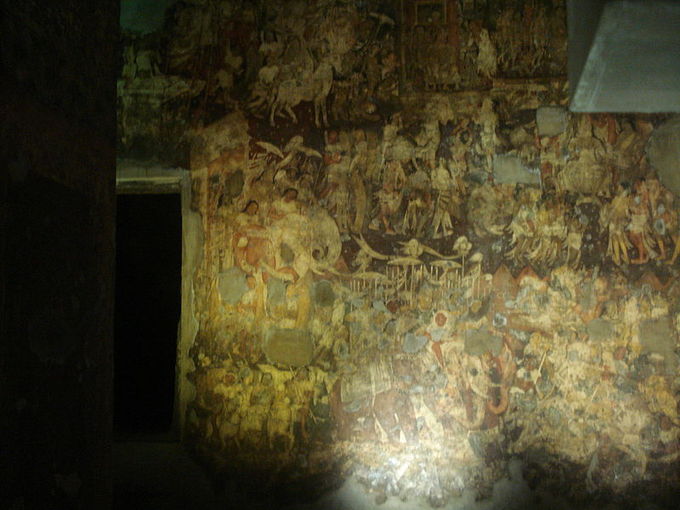
Ajanta cave painting: An example of a painting from one of the Ajanta caves.
Sittanavasal
Sittanavasal dates from the 2nd century and is the most famous of the Jain rock-cut monasteries. It contains remnants of beautiful frescoes believed to be from the 7th to 9th centuries. Again, the themes of the frescoes are religious and generally employ a palette consisting of black, green, yellow, orange, blue, and white.
In addition to wall murals, there are paintings on the ceiling of Sittanavasal from the 9th century that depict elephants, buffalo, fish, geese, dancing girls, and lotus flowers. These frescoes, along with those of the Ajanta caves and Bagh, are considered to be the high point of Medieval Indian art.
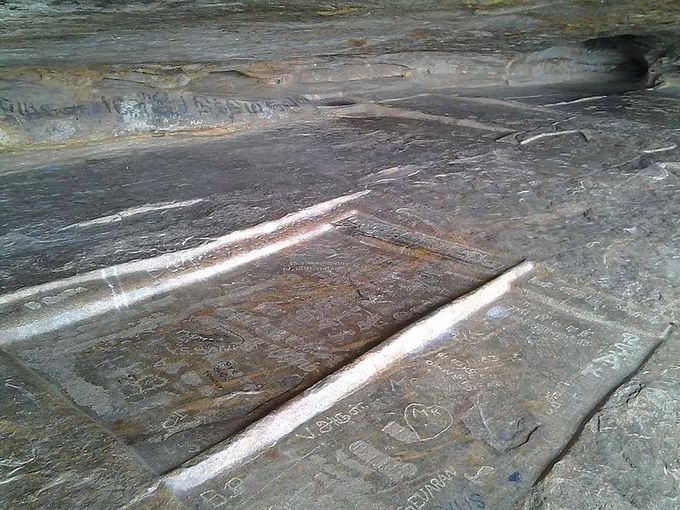
A painting from Sittanavasal: Sittanavasal contains remnants of beautiful frescoes believed to be from the 7th to 9th centuries.
Miniature Painting
Miniature painting is believed to have started in the eastern part of medieval India, as exemplified by illustrations on palm-leaf religious manuscripts that are painted on the leaves and wooden covers of the manuscripts. Some of the most common Buddhist illustrated manuscripts include the Astasahasrika Prajnaparamita, the Pancharaksa, the Karandavyuha, and the Kalachakrayanatantra.
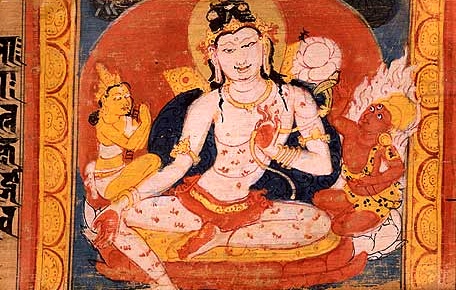
Detail of an illuminated manuscript: The detail on this piece of artwork was created circa 700–1100 CE.
Miniature painting is thought to have developed slightly later in western India, somewhere between the 10th and 12th centuries, and it generally exists with Hindu and Jain texts.
Human figures are seen predominantly from a profile view, with large eyes, pointy noses, and slim waists. The color palette often employs black, red, white, brown, blue, and yellow.
While it is believed that miniature painting came into existence during the medieval period, it was to flourish extensively from the 16th to 19th centuries during the Mughal empire .
Greco-Buddhist Art
The art styles of Gandhāra and Mathura are noted for their distinctive style of Buddhist art influenced by Greek culture.
Learning Objectives
Give examples of the Greek influence on the Buddhist Gadhara style of art
Key Takeaways
Key Points
- Gandhāra is the name of an ancient kingdom located in parts of modern-day northern Pakistan and eastern Afghanistan that lasted from the early first millennium BCE to the 11th century CE.
- The Gandhāran art style flourished and achieved its peak during the Kushan period, from the 1st to the 5th century. It declined and suffered destruction after the invasion of the White Huns in the 5th century.
- Gandhāra is noted for its distinctive style of Buddhist art, which developed out of a merger of Greek, Syrian, Persian, and Indian artistic influences. Gandhāran Buddhist sculpture displays a Greek artistic influence that contributes to depictions of wavy hair, drapery covering both shoulders, shoes, and sandals.
- Stucco was widely used by sculptors in Gandhāra for the decoration of monastic and cult buildings; it provided the artist with a medium of great plasticity and enabled a high degree of expressiveness to be given to the sculpture.
- Although based on a strong Indian tradition, the art of Mathura also incorporated elements of the Hellenistic tradition, such as a general idealistic realism , and key design elements, such as curly hair and folded garments.
- The Mathura and Gandhāra art styles strongly influenced each other, and it is still a matter of debate whether the anthropomorphic representations of Buddha were essentially a result of a local evolution of Buddhist art at Mathura or a consequence of Greek cultural influence in Gandhāra.
Key Terms
- stucco: A plaster that is used to coat interior or exterior walls or used for moldings.
Overview: Gandhāra and Mathura
In ancient art, anthropomorphic representations of the Buddha started to emerge from the 1st century CE in Northern India. The two main centers of creation have been identified as Gandhāra in today’s North West Frontier Province in Pakistan, and the region of Mathura in central northern India.
Gandhāran Art
Introduction
Gandhāra is the name of an ancient kingdom located in parts of modern-day northern Pakistan and eastern Afghanistan, mainly in the Peshawar Valley, the Pothohar Plateau, and the Kabul River Valley. The Kingdom of Gandhāra lasted from the early first millennium BCE to the 11th century CE.
The art style of the Kingdom flourished and achieved its peak during the Kushan period, from the 1st to the 5th centuries; it then declined and suffered destruction after the invasion of the White Huns in the 5th century.
Style
Gandhāra is noted for its distinctive style of Buddhist art, which developed out of a merger of Greek, Syrian, Persian, and Indian artistic influences. This development began during the Parthian Period (50 BCE–CE 75).
The art of Gandhāra benefited from centuries of interaction with Greek culture after the conquests of Alexander the Great in 332 BCE and the subsequent establishment of the Greco-Bactrian and Indo-Greek Kingdoms, which led to the development of Greco-Buddhist art.
In Gandhāran art, the Buddha is often shown under the protection of the Greek god Herakles, standing with his club (and later a diamond rod) resting over his arm. This unusual representation of Herakles is the same as the one seen only on the back of of Demetrius’s coins, and it is exclusively associated to him (and his son Euthydemus II).
Gandhāran Buddhist sculpture displays Greek artistic influence, and it has been suggested that the concept of the man-god was essentially inspired by Greek mythological culture. Artistically, the Gandhāran School of sculpture is said to have contributed wavy hair, drapery covering both shoulders, shoes, sandals, and acanthus leaf decorations.
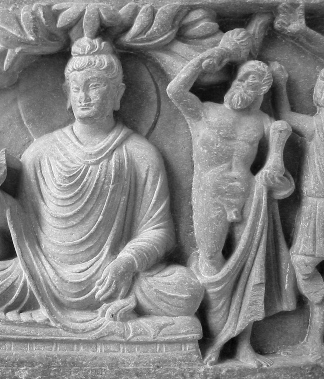
Buddha Herakles: The Buddha and Vajrapani under the guise of Herakles.
Stone was widely used by sculptors in Gandhāra for the decoration of monastic and cult buildings, and stucco provided the artist with a medium of great plasticity, enabling a high degree of expressiveness to be given to the sculpture. Sculpting in stucco was popular wherever Buddhism spread from Gandhāra: India, Afghanistan, Central Asia, and China.
Mathura Style
Introduction
Mathura is a city in the North Indian state of Uttar Pradesh. The art of Mathura tends to be based on a strong Indian tradition, exemplified by the anthropomorphic representation of divinities such as the Yaksas, although in a style rather archaic compared to the later representations of the Buddha.
The Mathuran school contributed to many new styles in art such as clothes of thin muslin that only cover the left shoulder, the wheel on the palm, and the lotus seat.
Art of Mathura
The representations of the Buddha in Mathura are generally dated slightly later than those of Gandhāra (although not without debate) and are also much less numerous. Mathura sculptures incorporate many Hellenistic elements, such as a general idealistic realism, and key design elements, such as curly hair and folded garments.
Specific Mathuran adaptations tend to reflect warmer climatic conditions, as they consist in a higher fluidity of the clothing, which progressively tends to cover only one shoulder instead of both. The art of Mathura also features frequent sexual imagery: female images with bare breasts or nude below the waist, displaying labia and female genitalia, are common, making these images more sexually explicit than those of earlier or later periods.

Mathura Buddha: The representations of the Buddha in Mathura are generally dated slightly later than those of Gandhāra (although not without debate) and are also much less numerous.
Relationship to Gandhāra Style
The Mathura and Gandhāra styles strongly influenced each other. During their artistic florescence, the two regions were united politically under the Kushans, both being capitals of the empire. It is still a matter of debate whether the anthropomorphic representations of Buddha were essentially a result of a local evolution of Buddhist art at Mathura, or a consequence of Greek cultural influence in Gandhāra through the Greco-Buddhist syncretism .
This iconic art was characterized from the start by a realistic idealism that combined realistic human features, proportions, attitudes, and attributes, together with a sense of perfection and serenity reaching to the divine. This expression of the Buddha as both man and God became the iconographic canon for subsequent Buddhist art.
Influences and Legacy
Hindu art began to develop from the 1st to the 2nd century CE and found its first inspiration in the Buddhist art of Mathura. It progressively incorporated a profusion of original Hindu stylistic and symbolic elements, in contrast with the general balance and simplicity of Buddhist art.
The art of Mathura acquired progressively more Indian elements and reached a very high sophistication during the Gupta Empire between the 4th and the 6th century CE. The art of the Gupta Period is considered the pinnacle of Indian Buddhist art.

Gupta Buddha: A statue of Buddha from the Gupta Period, Musée Guimet, Paris.
- Curation and Revision. Provided by: Boundless.com. License: CC BY-SA: Attribution-ShareAlike
- Sanchi stupa. Provided by: Wikimedia. Located at: commons.wikimedia.org/wiki/File:Sanchi_stupa.jpg. License: CC BY-SA: Attribution-ShareAlike
- Stupa. Provided by: Wikipedia. Located at: en.Wikipedia.org/wiki/Stupa. License: CC BY-SA: Attribution-ShareAlike
- relic. Provided by: Wiktionary. Located at: en.wiktionary.org/wiki/relic. License: CC BY-SA: Attribution-ShareAlike
- mantra. Provided by: Wiktionary. Located at: en.wiktionary.org/wiki/mantra. License: CC BY-SA: Attribution-ShareAlike
- SamadhiStatue. Provided by: Wikipedia. Located at: en.Wikipedia.org/wiki/File:SamadhiStatue.JPG. License: Public Domain: No Known Copyright
- Sigiri Frescos. Provided by: Wikipedia. Located at: en.Wikipedia.org/wiki/File:Sigiri_Frescos.jpg. License: CC BY-SA: Attribution-ShareAlike
- Vatadage. Provided by: Wikipedia. Located at: en.Wikipedia.org/wiki/File:Vatadage.jpg. License: Public Domain: No Known Copyright
- Buddhist Architecture. Provided by: Wikipedia. Located at: en.Wikipedia.org/wiki/Buddhist_architecture. License: CC BY-SA: Attribution-ShareAlike
- Architecture of Sri Lanka. Provided by: Wikipedia. Located at: en.Wikipedia.org/wiki/Architecture_of_Sri_Lanka. License: CC BY-SA: Attribution-ShareAlike
- Dances of Sri Lanka. Provided by: Wikipedia. Located at: en.Wikipedia.org/wiki/Dances_of_Sri_Lanka. License: CC BY-SA: Attribution-ShareAlike
- Architecture of ancient Sri Lanka. Provided by: Wikipedia. Located at: en.Wikipedia.org/wiki/Architecture_of_ancient_Sri_Lanka. License: CC BY-SA: Attribution-ShareAlike
- Music of Sri Lanka. Provided by: Wikipedia. Located at: en.Wikipedia.org/wiki/Music_of_Sri_Lanka. License: CC BY-SA: Attribution-ShareAlike
- Culture of Sri Lanka. Provided by: Wikipedia. Located at: en.Wikipedia.org/wiki/Culture_of_Sri_Lanka. License: CC BY-SA: Attribution-ShareAlike
- Sigiriya. Provided by: Wikipedia. Located at: en.Wikipedia.org/wiki/Sigiriya. License: CC BY-SA: Attribution-ShareAlike
- vatadage. Provided by: Wikipedia. Located at: en.Wikipedia.org/wiki/vatadage. License: CC BY-SA: Attribution-ShareAlike
- stupa. Provided by: Wiktionary. Located at: en.wiktionary.org/wiki/stupa. License: CC BY-SA: Attribution-ShareAlike
- AJANTA CAVES - C.SHELARE (1). Provided by: Wikimedia. Located at: commons.wikimedia.org/wiki/File:AJANTA_CAVES_-_C.SHELARE_(1).jpg. License: CC BY-SA: Attribution-ShareAlike
- Ellora Caves, Picture 4. Provided by: Wikimedia. Located at: commons.wikimedia.org/wiki/File:Ellora_Caves,_Picture_4.JPG. License: CC BY-SA: Attribution-ShareAlike
- Rock-cut architecture. Provided by: Wikipedia. Located at: en.Wikipedia.org/wiki/Rock-cut_architecture. License: CC BY-SA: Attribution-ShareAlike
- Ellora Caves. Provided by: Wikipedia. Located at: en.Wikipedia.org/wiki/Ellora_Caves. License: CC BY-SA: Attribution-ShareAlike
- List of rock-cut temples in India. Provided by: Wikipedia. Located at: en.Wikipedia.org/wiki/List_of_rock-cut_temples_in_India. License: CC BY-SA: Attribution-ShareAlike
- Vihara. Provided by: Wikipedia. Located at: en.Wikipedia.org/wiki/Vihara. License: CC BY-SA: Attribution-ShareAlike
- Indian rock-cut architecture. Provided by: Wikipedia. Located at: en.Wikipedia.org/wiki/Indian_rock-cut_architecture. License: CC BY-SA: Attribution-ShareAlike
- Barabar Caves. Provided by: Wikipedia. Located at: en.Wikipedia.org/wiki/Barabar_Caves. License: CC BY-SA: Attribution-ShareAlike
- cornice. Provided by: Wiktionary. Located at: en.wiktionary.org/wiki/cornice. License: CC BY-SA: Attribution-ShareAlike
- pilaster. Provided by: Wiktionary. Located at: en.wiktionary.org/wiki/pilaster. License: CC BY-SA: Attribution-ShareAlike
- tempera. Provided by: Wiktionary. Located at: en.wiktionary.org/wiki/tempera. License: CC BY-SA: Attribution-ShareAlike
- Ajanta Cave Painting. Provided by: Wikimedia. Located at: commons.wikimedia.org/wiki/File:Ajanta_Cave_Painting.JPG. License: CC BY-SA: Attribution-ShareAlike
- Astasahasrika Prajnaparamita Avalokitesvara Bodhisattva Nalanda. Provided by: Wikipedia. Located at: en.Wikipedia.org/wiki/File:Astasahasrika_Prajnaparamita_Avalokitesvara_Bodhisattva_Nalanda.jpeg. License: Public Domain: No Known Copyright
- er-des-6.-jahrhunderts-001.%402x.jpeg. Provided by: Wikipedia. Located at: en.Wikipedia.org/wiki/File:Indischer_Maler_des_6._Jahrhunderts_001.jpg. License: Public Domain: No Known Copyright
- Samanar Padukkai. Provided by: Wikimedia. Located at: commons.wikimedia.org/wiki/File:Samanar_Padukkai.jpg. License: CC BY-SA: Attribution-ShareAlike
- Boundless. Provided by: Boundless Learning. Located at: www.boundless.com//art-history/definition/album-leaves. License: CC BY-SA: Attribution-ShareAlike
- Gupta and Post-Gupta. Provided by: Boundless. Located at: www.boundless.com/users/307859/textbooks/painting-1-8adf00aa-c11d-45a0-864a-1de2e11ad1f5/art-of-south-and-southeast-asia-before-1200-south-and-southeast-asia-after-1200-17/the-shungas-and-early-andhras-156/gupta-and-post-gupta-621-10499/. License: CC BY: Attribution
- Perfection of Wisdom. Provided by: Wikipedia. Located at: en.Wikipedia.org/wiki/Perfection_of_Wisdom. License: CC BY-SA: Attribution-ShareAlike
- Sittanavasal. Provided by: Wikipedia. Located at: en.Wikipedia.org/wiki/Sittanavasal. License: CC BY-SA: Attribution-ShareAlike
- Cave paintings in India. Provided by: Wikipedia. Located at: en.Wikipedia.org/wiki/Cave_paintings_in_India. License: CC BY-SA: Attribution-ShareAlike
- Indian painting. Provided by: Wikipedia. Located at: en.Wikipedia.org/wiki/Indian_painting%23Malwa.2C_Deccan_and_Jaunpur_schools_of_painting. License: CC BY-SA: Attribution-ShareAlike
- Visual Arts Of The Indian Subcontinent. Provided by: Wikibooks. Located at: en.wikibooks.org/wiki/Visual_Arts_Of_The_Indian_Subcontinent. License: CC BY-SA: Attribution-ShareAlike
- fresco. Provided by: Wiktionary. Located at: en.wiktionary.org/wiki/fresco. License: CC BY-SA: Attribution-ShareAlike
- Buddha-Herakles. Provided by: Wikipedia. Located at: en.Wikipedia.org/wiki/File:Buddha-Herakles.JPG. License: CC BY-SA: Attribution-ShareAlike
- 315px-guptabuddha.%402x.jpeg. Provided by: Wikipedia. Located at: en.Wikipedia.org/wiki/File:GuptaBuddha.jpg. License: Public Domain: No Known Copyright
- 296px-mathurabuddha.jpeg. Provided by: Wikipedia. Located at: en.Wikipedia.org/wiki/File:MathuraBuddha.JPG. License: Public Domain: No Known Copyright
- Mathura Style. Provided by: Boundless. Located at: www.boundless.com/users/307859/textbooks/painting-1-8adf00aa-c11d-45a0-864a-1de2e11ad1f5/art-of-south-and-southeast-asia-before-1200-south-and-southeast-asia-after-1200-17/kushan-and-later-andhra-periods-157/mathura-style-624-5351/. License: CC BY: Attribution
- Greco-Buddhist art. Provided by: Wikipedia. Located at: en.Wikipedia.org/wiki/Greco-Buddhist_art. License: CC BY-SA: Attribution-ShareAlike
- Gandhara. Provided by: Wikipedia. Located at: en.Wikipedia.org/wiki/Gandhara%23Art. License: CC BY-SA: Attribution-ShareAlike
- Buddhist art. Provided by: Wikipedia. Located at: en.Wikipedia.org/wiki/Buddhist_art. License: CC BY-SA: Attribution-ShareAlike
- gandhara. Provided by: Wikipedia. Located at: en.Wikipedia.org/wiki/gandhara. License: CC BY-SA: Attribution-ShareAlike
- stucco. Provided by: Wiktionary. Located at: en.wiktionary.org/wiki/stucco. License: CC BY-SA: Attribution-ShareAlike
- Style (visual arts). Provided by: Wikipedia. Located at: en.Wikipedia.org/wiki/Style_(visual_arts). License: CC BY-SA: Attribution-ShareAlike

